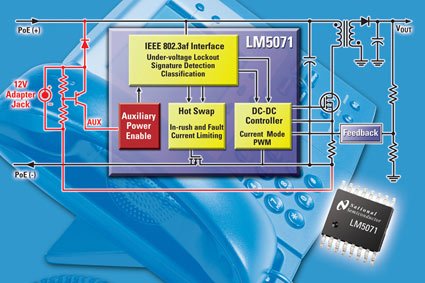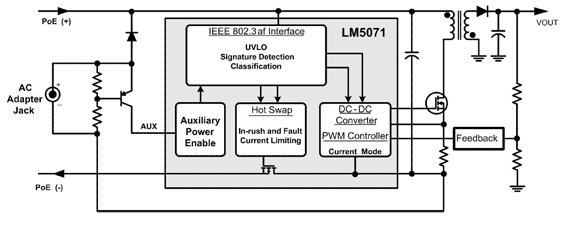LM5071 Offers Designers Better Flexibility to Operate PoE Powered Devices from AC Adapters as Low as 9.5V or from the Power Sourcing Equipment
National Semiconductor announced the industry’s first single-chip solution specifically designed for Power over Ethernet (PoE) devices that operate from alternative power sources or the PoE-enabled network. The LM5071 is a Powered Device (PD) interface and DC-DC converter IC that simplifies the design of a variety of PoE applications that require an auxiliary power source such as an AC adapter.

Devices powered by a PoE network include IP phones, security cameras and wireless local area network (WLAN) nodes connected through Ethernet networking cables and ports. Operating these PoE devices from alternate power sources is often necessary to relieve the burden on the Power Sourcing Equipment (PSE) or to operate the device on a network that is not PoE-enabled. Current solutions limit the choice of auxiliary power sources, which can drive up overall system cost or complexity.

National’s LM5071 is the industry’s first single-chip, IEEE 802.3af-compliant PD interface port and pulse-width modulator (PWM) controller specifically designed to accept power from external AC adapters. The LM5071 integrates a PD front end that accepts power from the PSE or auxiliary power to a single chip with a DC-DC controller that steps down the input voltage to power various PD loads.
Key Technical Specifications
The LM5071 is fabricated with National’s ABCD150-XV1 high-voltage analog bipolar/CMOS/DMOS technology and offers advantages such as an integrated, high-frequency, current-mode DC-DC controller, user-programmable under-voltage threshold and hysteresis, and a highly accurate fault current control loop. It features a maximum input voltage of 80V, user-programmable oscillator frequency up to 1 MHz and over-temperature protection, plus a voltage reference and high-performance error amplifier for non-isolated applications.
Compelling Features and Benefits
National’s LM5071 has a number of unique characteristics that make it easy to design in:
- Auxiliary power interface: Accepts a wide range of auxiliary power source voltages (12V to 48V) and activates the DC-DC converter to efficiently supply the various loads of the PD.
- UVLO threshold and hysteresis: Designers can program the under-voltage lockout (UVLO) trip-point and hysteresis completely independently. This allows precise control of start-up line currents and the start and stop voltage points as desired in a variety of system applications.
- Controls isolated or non-isolated DC-DC converters: Integrates the precision voltage reference and error amplifier for DC-DC feedback in non-isolated converters, including the simple Buck topology. Provides internal pull-up for opto-coupler transistor in isolated designs.
- Signature resistor disconnect: The 25 kilohm signature resistor is disconnected after PD detection to reduce power loss.
- Programmable oscillator frequency: The oscillator for the switching regulator controller is fully programmable, allowing the user to optimize regulator performance.
- 50 percent or 80 percent maximum duty cycle: Available with either 50 percent or 80 percent maximum PWM duty cycle to support a variety of DC-DC converter topologies and permit operation over an extended input voltage range.
